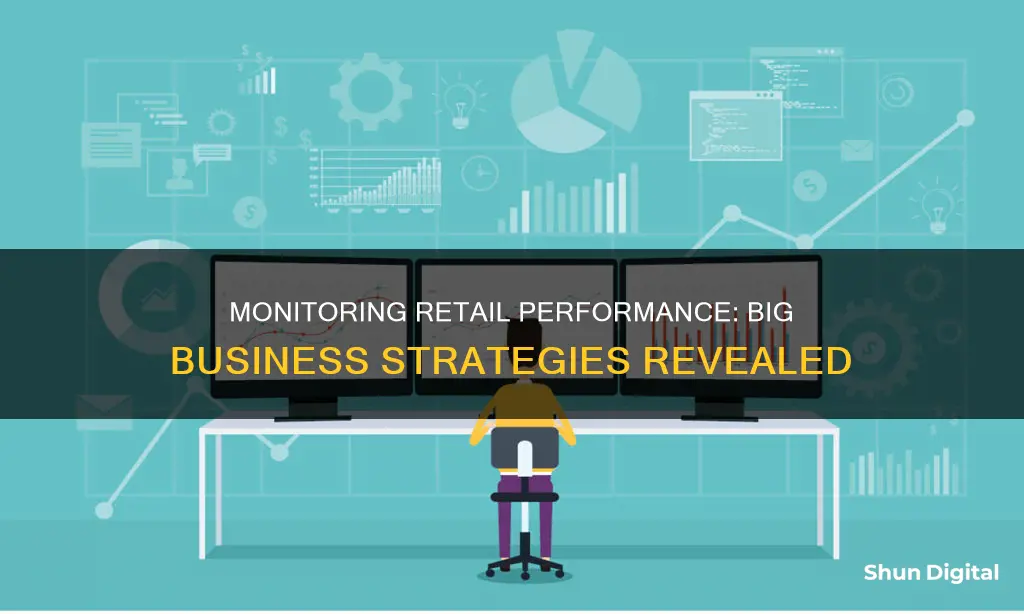
Monitoring retail performance is essential for businesses to gauge their health and make informed decisions. Retail Key Performance Indicators (KPIs) provide an objective measurement of a store's performance, helping businesses identify areas for improvement and set strategic goals. While the specific KPIs tracked vary depending on the business's goals, some common metrics include customer traffic, sales per employee, conversion rate, inventory turnover, and average transaction value. These KPIs offer insights into customer behaviour, sales metrics, inventory performance, and growth performance, enabling businesses to enhance their financial analysis and boost profits. By closely monitoring these indicators and making data-driven decisions, companies can improve their retail performance and stay competitive in the market.
| Characteristics | Values |
|---|---|
| Number of Customers | Customer Traffic |
| Effectivity | Retail Conversion Rate |
| Average Sale | Average Purchase Value |
| Items per Purchase | Size of an Average Shopping Cart |
| Gross Margin | Sales Profit Before Costs |
| Units per Transaction | Average Items per Transaction |
| Sales per Employee | Net Sales / Number of Employees |
| Sales per Square Foot | Revenue per Square Foot of Sales Space |
| Average Transaction Value | Total Revenue / Number of Transactions |
| Gross Margin Return on Investment | Gross Profit / Average Inventory Cost |
| Customer Retention Rate | Percentage of Customers Retained Over a Tracked Period |
| Customer Acquisition Cost | Marketing, Sales, and Other Expenses per Customer |
| Comparable Store Sales | Revenue from Recent Accounting Period vs. Previous Period |
What You'll Learn

Customer traffic/foot traffic
Foot traffic is a critical metric for big companies to monitor retail performance. It refers to the number of customers who enter a physical store, and it is a key factor in the success of any retail business. Higher foot traffic generally leads to higher sales and revenue, so increasing customer traffic is a constant goal for retailers.
Methods of Tracking Foot Traffic
There are several methods for tracking foot traffic, each with its advantages and drawbacks.
- Manual Counting: This involves having someone sit at the entrance and count every person who comes in. It is affordable but time-consuming and inaccurate.
- Automated Sensors: Sensors can be placed at entry and exit points to count people as they pass through. While accurate, these sensors are expensive and may not work with all types of doors.
- Video Analytics: Special cameras can be installed to analyze customer movement and identify patterns in visitor flow. This method can be complex and expensive, requiring additional infrastructure to store and analyze the footage.
- Mobile Device Tracking: By using GPS technology, retailers can track customer movements within their store anonymously. This provides a wider scope of analysis than physical solutions like video cameras.
- Wi-Fi and Bluetooth Tracking: This method captures signals from customers' mobile devices to monitor their movements.
- People Counting Systems: These use infrared detectors to detect and record the movement of individuals within an area.
Benefits of Tracking Foot Traffic
Tracking foot traffic provides valuable insights that can inform strategic decisions.
- Understanding Customer Behavior: By analyzing foot traffic data, retailers can gain insights into customer behavior and preferences, which helps them make informed decisions about store layout, product placement, and marketing strategies.
- Optimizing Staffing: Foot traffic data helps retailers identify peak hours and days, allowing them to schedule more staff during busy periods and cut costs during slower times.
- Improving Store Layout: Tracking customer flow through the store helps identify high-traffic areas and inefficient layouts. This information can be used to optimize the store layout, improve traffic flow, and increase sales through strategic product placement.
- Measuring Marketing Effectiveness: Foot traffic data allows retailers to evaluate the effectiveness of their marketing campaigns. If a particular campaign is not attracting people to the store, they can adjust their strategy.
- Planning Inventory: By understanding foot traffic patterns, retailers can better plan their inventory levels and avoid lost sales or overstocking.
- Site Selection: Foot traffic analysis is crucial for selecting the optimal location for a new store. It helps retailers understand the viability and profitability of different areas.
Strategies to Increase Foot Traffic
To boost foot traffic, retailers can focus on various factors such as location, store appearance, customer service, product offerings, and marketing promotions.
- Location and Accessibility: Choosing a prime location in high-traffic areas, such as malls or popular streets, increases the likelihood of attracting more customers. Ensuring accessibility through various transportation modes is also essential.
- Store Appearance and Ambiance: A well-maintained exterior and an engaging, clean, and visually appealing interior can leave a positive impression on potential customers.
- Customer Service: Knowledgeable, friendly, and attentive staff can encourage customers to spend more time in the store and increase the likelihood of purchases.
- Product Variety and Pricing: Offering a diverse range of products that meet customer needs and competitive pricing are crucial for driving foot traffic.
- Marketing and Promotions: Effective marketing and promotional strategies across various channels, such as social media, email, and local advertising, can significantly increase foot traffic.
- In-Store Events: Hosting events, product demonstrations, instruction classes, or offering free samples can attract more visitors to the store.
Foot traffic is a vital metric for big companies to understand and improve their retail performance. By tracking and analyzing customer traffic, retailers can make data-driven decisions to enhance the customer experience, optimize their operations, and ultimately, increase sales and revenue.
Connecting the 295x2: A Step-by-Step Guide to Monitor Hookup
You may want to see also

Customer retention rate
A high customer retention rate is integral to a company's success, and a 100% retention rate is always good. However, what constitutes a good or bad retention rate varies by industry. For example, the retention rate in the retail industry is relatively low due to high competition and the ease of switching brands. In contrast, industries like banking and telecom have higher retention rates due to customer satisfaction and the "difficulty to leave" factor.
To calculate the customer retention rate, use the formula: Retention Rate = ((CE-CN)/CS)) x 100, where CE is the number of customers at the end of the period, CN is the number of new customers acquired, and CS is the number of customers at the start.
Big companies monitor customer retention rates to evaluate their products' quality and effectiveness, as well as their overall customer service performance and customer loyalty. By tracking this metric, companies can identify areas for improvement and make strategic decisions to enhance customer satisfaction and retention.
Additionally, companies can employ retention software to automate retention processes, cut retention costs, and stay ahead of the competition. They can also focus on customer success, ensuring that their products or services address key pain points and help customers achieve their goals, leading to higher retention rates.
Best Places to Buy Little British Monitors
You may want to see also

Sales per employee
Tracking sales per employee is a key performance indicator (KPI) that gives a snapshot of sales associates' performance. This KPI is calculated by dividing net sales by the number of employees. For example, if a retailer has four employees and net sales of $11,500, then its sales per employee would be $2,875 per employee.
POS systems that give each employee a sign-in code can be used to track daily, weekly, and monthly sales per employee. This data can help identify opportunities for training and individual recognition, as well as planning work schedules and sales incentives.
Best Monitor Alternatives to the ASUS PG279Q
You may want to see also

Customer conversion rate
A low conversion rate could indicate that improvements are needed in customer retention, inventory management, or the point of sale. For example, providing relevant product collateral and encouraging employees to build rapport with customers can help turn browsers into buyers. Additionally, loyalty programs can make it easier to understand customer traffic and identify returning customers.
The average conversion rate for e-commerce sites is about 2-3%, but this varies by industry. For clothing and apparel stores, a typical conversion rate is 18-25%. Businesses should aim to outperform their competitors and industry peers by improving their conversion rates.
By tracking customer conversion rates, businesses can identify areas for improvement and develop effective retail strategic plans. This metric is essential for making data-driven decisions and optimising financial performance in the highly competitive retail landscape.
IPS Monitor Buying Guide: Choosing the Best Display
You may want to see also

Inventory turnover
Alternatively, some retailers may use sales figures instead of COGS:
A higher inventory turnover ratio generally indicates strong sales and effective inventory management practices. This means that inventory is sold more frequently throughout the year, preventing items from sitting on shelves for too long. As a result, higher turnover can lead to increased profitability by driving higher gross margins.
On the other hand, a lower inventory turnover ratio may signal weak sales, excess inventory, or poor inventory planning. This can result in capital being tied up in unsold goods, impacting the business's liquidity and profitability.
For example, a retailer with $1,000,000 in sales and an average inventory level of $250,000 during the year would have an inventory turnover of 4. This means that, on average, the retailer sold its entire inventory stock four times over during that year.
While inventory turnover is a valuable metric, it should be assessed alongside other measurements to gain a comprehensive view of inventory health and performance. Some limitations to consider are that inventory turnover can vary widely by industry, it ignores profitability, it doesn't factor in stockouts, and it may lack context when viewed in isolation.
To address these limitations, retailers should compare their inventory turnover against competitors within their specific industry vertical and market segment. Additionally, turnover metrics should be analysed in conjunction with profitability metrics and optimal inventory levels to make informed decisions.
Recording Monitors: Interface Connection Guide for Beginners
You may want to see also
Frequently asked questions
One simple way to monitor retail performance is to focus on five essential sales metrics: number of customers, retail conversion rate, average sale, items per purchase, and gross margin.
Some important metrics for monitoring retail performance include customer traffic, sales per employee, customer retention rate, average transaction value, and year-over-year growth.
To improve retail performance, you can set specific goals and track relevant key performance indicators (KPIs). You can also compare your performance to that of your competitors and make data-driven decisions to optimize your sales strategies, inventory management, and marketing campaigns.
There are various tools available to help monitor retail performance, such as people counters, retail analytics software, and point-of-sale (POS) systems. These tools can provide insights into foot traffic, sales data, inventory management, and customer behaviour.







